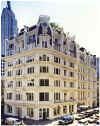 |
New York Architecture Images-Gramercy Park Gilsey House |
|
architect |
Stephen Decatur Hatch, Badger,Daniel |
|
location |
1200 Broadway |
|
date |
1869 |
|
style |
Second Empire Baroque |
|
construction |
Cast Iron Facade and slate roofs Daniel Badger of Architectural Ironworks |
|
type |
Hotel |
|
|
|
|
images |
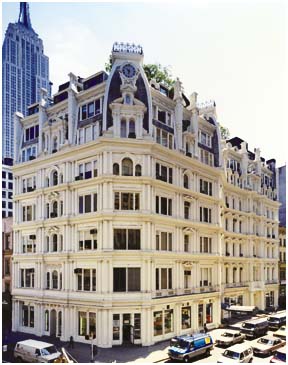 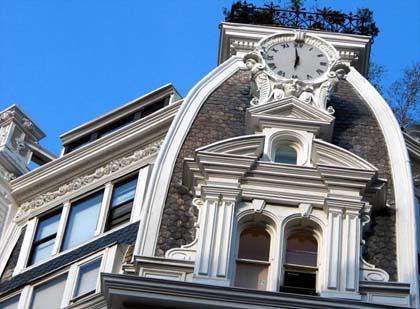 |
|
|
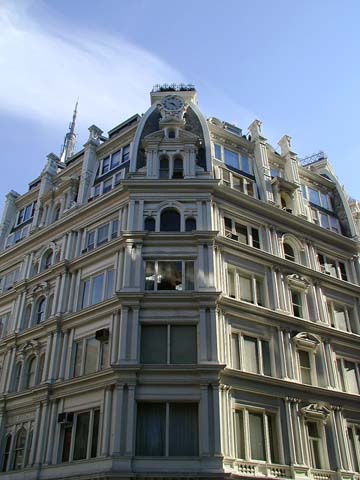 |
|
Opened in 1871 as the Gilsey Hotel, this
cast-iron Second Empire landmark was the first hotel in the city to
offer telephone service to guests. It was a favorite of Diamond Jim
Brady and Oscar Wilde. Converted to housing in 1979.
The Gilsey at Twenty-ninth Street on the east side, the Grand [Hotel] at Thirty-first Street, just above, now called the New Grand, the Coleman House on the west side between Twenty-seventh and Twenty-eighth streets, the Hotel Martinique at the north-east corner of Thirty-second Street, and the Sturtevant at 1186 Broadway, a favorite stopping place for officers of the army and navy. The last two have disappeared, the Gilsey is termed the New Breslin, and the Imperial at Thirty-first to Thirty-second streets, the finest hotel of all, has been erected and enlarged within less than fifteen years. Where the Gilsey House now stands was the field of the St. George Cricket Club, which was formed by the Englishmen who patronized Clark and Brown's English chop-house in Maiden Lane; the grounds of the club are now on Staten Island. At the southeast corner of Twenty-sixth Street, Delmonico's up-town restaurant was located from 1876 to 1888, when the Cafe Martin took its place and succeeded to its popularity. There are a number of well-known restaurants and Rathskellers on this part of the thoroughfare. In 1868. Peter Gilsey purchased the last
homestead in midtown from Caspar Samlar, and built a hotel. The cast
iron was supplied by Architectural Ironworks. Diamond Jim Brady may have set his watch by
this clock when he arrived The Gilsey House, a sporty theatrical hotel at Broadway and 29th Street, was still a favorite meeting place for people of the amusement world; theater folk also flocked to the Holland House and to Considine's and to Jack's and the Metropole. The Astor, in all its magnificent bulk, had reared itself at Times Square. Playgoers were discovering Sixth Avenue via the mighty Hippodrome. William Faversham, who had learned his trade with the fine Lyceum and Empire stock companies, had a solid success in The Squaw Man at Wallack's. Robert B. Mantell was roaring as King Lear at the Garden. Lillian Russell, still highly paid but on the downgrade artistically, was singing twice daily at Proctor's 125th Street. Viola Allen was engaged with a minor comedy, Fitch Toast of the Town. Margaret Anglin was at the Princess in Zira. The long-legged and frequently funny Richard Carle was in The Mayor of Tokyo at the New York, and another laugh specialist, Eddie Foy, had The Earl and the Girl at the Casino. "Variety," the theatrical weekly, founded by the sagacious Sime Silverman, was preparing to come forth with its first issue. Burns Mantle, from out of Denver, was covering plays for the "Chicago Inter-Ocean." Ashton Stevens was the outspoken critic of the "San Francisco Examiner"; George Jean Nathan, Cornell'04, was about to enter journalism via the "New York Herald." And the brassy, flag-waving George M. Cohan, of the crazy dance and the kangaroo walk, had opened his Forty-five Minutes from Broadway out of town and had a booking for the New Amsterdam. He brought it in as his New Year's gift to Broadway, on the very first evening in 1906. It had been Cohan's intention to make it a show for Fay Templeton, who played the housemaid, Mary Jane Jenkins, but by the time the production reached the 42d Street the reformed vaudeville actor, Victor Moore, in the role of the slangy Kid Burns, had completely taken over. |
|
|
Currently adjacent to the Gilsey House is the
Breslin House, SE corner of 29th and Broadway. Breslin Apartments;
formerly Breslin Hotel. Houses Silver Street, Speed Zone Inc., Drama
Ltd. Creative Clothing and other wholesalers. Previously on this site
was Sturtevant House, where on June 2, 1873, novelist Mansfield Walworth
was shot to death by his son for making threats against the son's
mother.
Sturtevant Broadway & 29th St. 1186
Broadway (southeast corner)
|
|
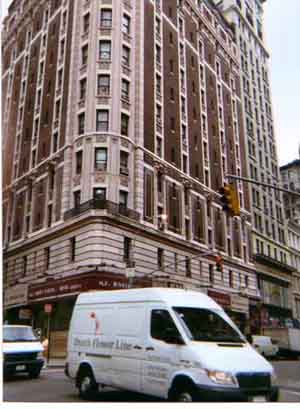 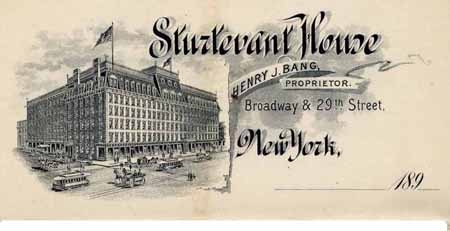
|
|
|
links |
|